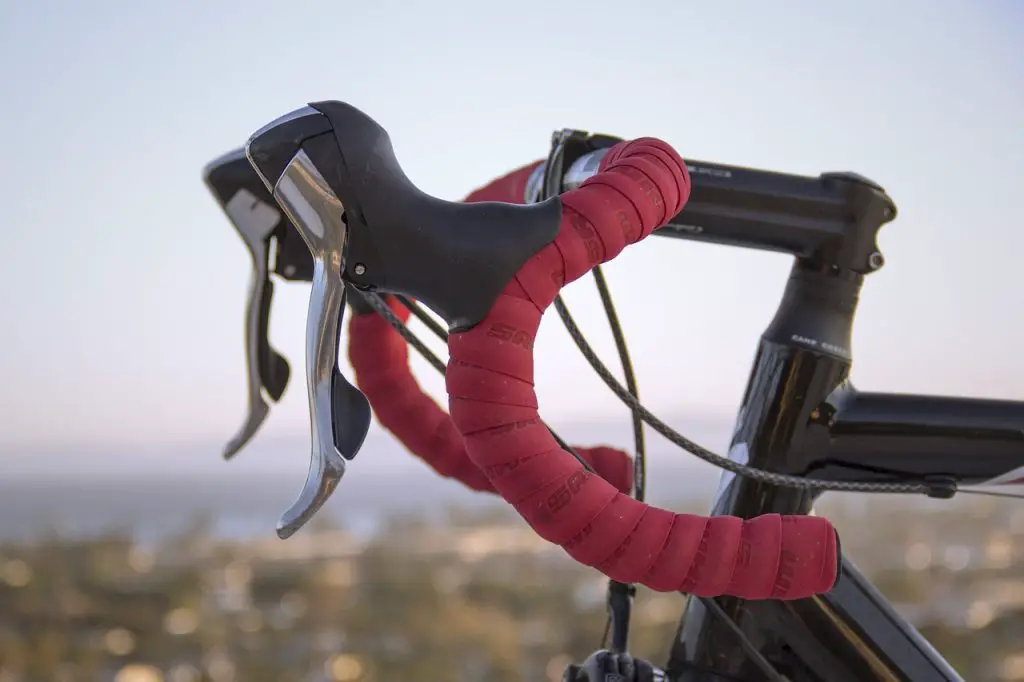Are you tired of feeling like you’re grasping at straws when it comes to selecting the perfect bike handlebars? This comprehensive guide has got you covered, from identifying the different types of handlebars to finding the ideal fit for your riding style. We’ll also discuss the key factors to consider when choosing handlebars for your bike.
You’ll discover how to choose the right handlebars, ensuring optimal comfort and control during your ride. By the end of this post, you’ll be equipped with the knowledge to make an informed decision about your bike handlebars, giving you a better grip on your cycling experience. So, let’s “handle” this together, shall we?
What are bike handlebars?
Bike handlebars are an essential component of a bicycle that allows the rider to steer and control the bike. They are part of the bike that the rider holds onto with their hands while riding. Bike handlebars come in various shapes, sizes, and materials and are designed to provide different riding positions, comfort levels, and levels of control.

Whether you are traveling a long distance or just a short commute, your riding position must be comfortable for you to ensure your safety and prevent injury. Choosing the right handlebars for your bike can significantly improve your ride quality and let you have a better position on the bike.
State Bicycle Co. Black Label 6061

State Bicycle Co. Black Label 6061
What are the different types of bike handlebars?
There are several types of bike handlebars, each designed for specific riding styles and preferences. Here are the main types and their primary uses:
1. Drop bars
Drop bars offer multiple hand positions, allowing riders to shift their grip for comfort or efficiency during long rides. The curved shape facilitates a more aerodynamic riding posture, which helps reduce wind resistance and improve speed. This makes them an excellent choice for cyclists who participate in high-speed cycling, long-distance rides, urban cycling, or competitive events.
2. Flat bars
Typically seen on mountain bikes, hybrids, and some city bikes, flat bars provide a more upright and relaxed riding position, offering better control and maneuverability, especially for off-road cycling.
3. Riser bars
Riser bars are similar to flat bars but have a slight upward curve. They give the rider a more upright and comfortable riding posture and are suitable for recreational cycling and off-road adventures.
4. Bullhorns
Popular among urban cyclists and single-speed bike enthusiasts, bullhorn handlebars have a forward extension and then curve back towards the rider, offering a more aggressive riding position and multiple hand placements.
5. Aero bars
Designed primarily for triathlons and time trial events, aero bars allow the rider to rest their forearms on the handlebars, reducing wind resistance and promoting an aerodynamic position for greater speed.
6. Mustache bars
With a unique shape that curves back towards the rider, mustache bars provide multiple hand positions, combining the benefits of drop bars and flat bars for a versatile, comfortable riding experience.
7. Cruiser bars
Also known as “swept-back” or “ape hanger” bars, cruiser bars are found on cruiser bikes and offer a very upright, relaxed riding posture, prioritizing comfort over performance.
How to choose a bike handlebar
To choose the right bike handlebar for your needs, follow these steps:
1. Match handlebar type to your riding style
Determine the primary type of cycling you’ll be doing, as each riding style has specific requirements in terms of control, comfort, and aerodynamics.
Road cycling
For high-speed cycling and long rides, drop bars offer multiple hand positions and an aerodynamic riding posture.
Mountain biking
Flat bars or riser bars provide better control and maneuverability for off-road cycling and technical terrain.

Commuting
Flat bars, riser bars, or bullhorn bars offer an upright riding position and good control, suitable for navigating urban traffic.
Leisure riding
Cruiser bars or mustache bars provide a relaxed and comfortable riding posture for casual cycling.
2. Choose your handlebar width
Riding with handlebars that are too wide or narrow can impact responsiveness and steering, making it challenging to control your bike. It can also lead to arm, neck, and back discomfort, particularly on longer rides. Over time, this discomfort can lead to long-term nerve damage, reducing your ability to ride comfortably and safely.
To choose the appropriate handlebar width for your bike, you can measure the distance between the bony protrusions on either side of your shoulders.
To choose the appropriate handlebar width for your bike, you can measure the distance between the bony protrusions on either side of your shoulders. Your handlebar width should be similar to your shoulder width for optimal comfort and control. If the handlebar width doesn’t feel right or if you experience discomfort, consider making adjustments to the handlebar or purchasing a different size.
3. Choose your handlebar reach, drop, rise, flare, sweep, and diameter
When choosing your bike handlebars, it’s important to consider the reach, drop, rise, flare, sweep, and diameter to ensure a comfortable and efficient riding experience. Here’s what to keep in mind:
Reach
The reach is the distance between the handlebar clamp and the forward-most part of the bar. Choose a reach that allows you to comfortably grip the brake levers and shifters without overreaching.
Drop
The drop is the distance between the top of the handlebar and the bottom of the drops. Choose a drop that matches your riding style and comfort level. Higher drops provide a more aggressive, aerodynamic posture for road cycling, while lower drops offer better control for off-road cycling.

Rise
The rise is the distance between the top of the handlebar and the center of the stem clamp area. Choose a rise that provides a comfortable riding posture for your body type and riding style.
Flare
The flare is the angle at which the handlebar bends outward from the stem clamp. Choose a flare that matches your riding style and comfort level. More flare provides better control and stability for off-road cycling, while less flare is more suitable for road cycling.
Sweep
The sweep is the angle at which the handlebar grips sweep back from the stem clamp. Choose a sweep that provides a comfortable hand position and control for your riding style.
Diameter
The diameter is the thickness of the handlebar at the stem clamp area. Ensure that the handlebar diameter matches the stem clamp diameter to ensure a secure fit.
4. Choose your handlebar material
Choosing the right handlebar material is essential to ensure a comfortable and durable riding experience. Both aluminum and carbon fiber handlebars are good choices. Carbon fiber handlebars are lighter and offer better shock absorption. They are also more expensive. On the other hand, aluminum handlebars are more affordable and offer comparable weight and stiffness to carbon fiber.
It’s essential to consider your riding style, budget, and personal preferences when choosing a handlebar material. For those on a budget, aluminum handlebars are a great option that provides excellent value for money. Investing in high-quality bar tape can also improve comfort and shock absorption, regardless of the handlebar material.
Are wider handlebars better?
Wider handlebars can have advantages for certain types of bikes and riders. They provide better stability and control, particularly when navigating technical terrain, as they offer more leverage and control over the bike. They also provide a more comfortable and open chest position, which can improve breathing and reduce fatigue, particularly on longer rides.
However, it may not be suitable for some riders. It is important to note that wider handlebars can be more challenging to maneuver in tight spaces, particularly if you have a narrower shoulder width. They may also put more strain on your arms, particularly if they’re not properly sized or adjusted.
Bike handlebar recommendations
There are many great handlebars available in the market to choose from, but here are some of my top picks:
1. Venzo Fixie Bike Bullhorn Pursuit Handlebars
These are made from high-grade alloy 6061, making them sturdy and extremely durable. They are also lightweight and offer a good grip to the rider.
2. FSA SL-K Compact Drop Handlebars
These handlebars are made of uni-directional carbon/ Kevlar monocoque construction, making them strong and durable. They are perfect for high-performance fixies.
3. Wald 803BL City Bicycle Mid-Rise Handlebar
This handlebar has a classic look and is designed for comfort and durability. It is ideal for urban riding.
4. Renthal Fatbar 35
This is an excellent aftermarket handlebar made of durable aluminum, providing a tried and true design that’s reasonably priced. It’s ideal for upgrading your bike’s cockpit.
5. Zipp Service Course 80 Ergonomic Handlebar
This is the best overall handlebar for road bikes, made of durable and lightweight aluminum with an ergonomic design.
6. UPANBIKE Fixed Gear Bike Handlebar
These handlebars are made of aluminum alloy, providing durability and affordability. They are also designed for fixies and are suitable for skidding, sprinting, or cruising.
If you want even more tips and insights, watch this video called “Bike Handlebars Explained” from the Zach Gallardo YouTube channel.
Conclusion
Well, folks, we’ve reached the finish line of our bike handlebars journey. So, do you feel more confident about selecting, installing, and maintaining your handlebars? And did I cover everything you wanted to know? Let me know in the comments section below – I read and reply to every comment.
If this guide helped you get a grip on the ins and outs of bike handlebars, don’t keep it to yourself! Share it with a fellow cyclist and explore my full blog for even more insights on all things fixie. Thanks for joining me on this journey, and remember, life is like riding a bicycle: to keep your balance, you must keep moving. Ride on, my friends!
Key takeaways
This article covered bike handlebars. Here are some key takeaways:
- Different types of bike handlebars serve various purposes and cater to different riding styles.
- Choosing the right handlebars involves considering factors like comfort, control, aerodynamics, and compatibility.
- Measuring and adjusting handlebars properly is crucial for optimal cycling performance and comfort.
- Regular maintenance and inspection of bike handlebars are essential for safety and enjoyment.
- Avoiding common mistakes in handlebar selection and use can lead to a better cycling experience.















